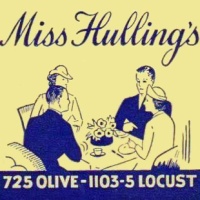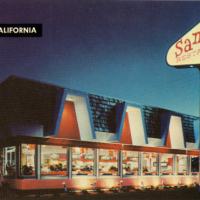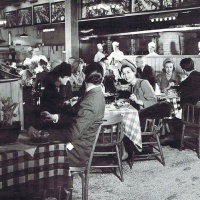Is any proof needed that restaurants are show business to a high degree – given that they are enveloped in mystique made up of names, signs, logos, lighting, decor, artistically arranged food, and costumed and scripted personnel?
And sometimes restaurateurs themselves are not the people they appear to be but are creations as carefully crafted as the stars of the entertainment world.
 After extensive research I’ve begun to wonder if the public persona of Ruby Foo was largely fictitious.
After extensive research I’ve begun to wonder if the public persona of Ruby Foo was largely fictitious.
She is often seen as a rare example of a Chinese woman who defied convention by creating a chain of stylish, nightclub-style Chinese restaurants that appealed to non-Chinese customers. It seems to me that however wealthy she became from the Ruby Foo restaurants, she had a turbulent and difficult life with three marriages and legal troubles that belied her vaunted glamorous life of jewels and furs, shopping in Paris, and flying her own plane.
To begin, note that she was indeed of Chinese ancestry but was born in California as were both her parents, who gave Ruby and her three siblings American first names. This casts doubt upon lore cranked out by gossip columnists who made much of her exotic identity. Their Ruby Foo seemed to have been born in China and had a mother who could not speak a word of English.
Some accounts say she opened her first restaurant in 1923. But she was married to an herbalist and living in Boston’s Back Bay in a house valued at $11,000 [pictured 2018], which was quite a lot at that time. She had a one-year-old and gave birth to her second child that year. Hard to believe that under those circumstances a woman would open a small lunch room for manual workers, as it has been described. I have been unable to find any trace of it.
 According to other tales, she opened her first restaurant in 1929, which is more believable, though I think it might have been a bit later. In publicity she is always represented as the sole proprietor, but when her brother George died in the 1960s, the Boston Globe reported that he had opened the “original” Den with Ruby. It could not have been called Ruby Foo’s Den then, because she had not yet divorced her first husband, Dr. Shong, and married Mr. Foo. A story in a New York City paper said that Ruby opened a restaurant in 1930 upon the death of Dr. Shong; actually, he died in 1933, by which time she had remarried. [Ruby Foo’s Den, Boston, ca. 1950]
According to other tales, she opened her first restaurant in 1929, which is more believable, though I think it might have been a bit later. In publicity she is always represented as the sole proprietor, but when her brother George died in the 1960s, the Boston Globe reported that he had opened the “original” Den with Ruby. It could not have been called Ruby Foo’s Den then, because she had not yet divorced her first husband, Dr. Shong, and married Mr. Foo. A story in a New York City paper said that Ruby opened a restaurant in 1930 upon the death of Dr. Shong; actually, he died in 1933, by which time she had remarried. [Ruby Foo’s Den, Boston, ca. 1950]
 Her second husband, Tam/Tom Foo, who she married sometime between 1930 and 1932, was a bookkeeper when they married and soon fell into big trouble when he embezzled $20,000 from his employer in 1932. Stories in the Boston Herald said the Chinese community regarded him as a scrupulously honest man who became money hungry when he married Ruby and adopted a more expensive lifestyle. Remarkably, by the time he died at age 47 in 1940 he had redeemed himself in the eyes of the community and was, indeed, an importer.
Her second husband, Tam/Tom Foo, who she married sometime between 1930 and 1932, was a bookkeeper when they married and soon fell into big trouble when he embezzled $20,000 from his employer in 1932. Stories in the Boston Herald said the Chinese community regarded him as a scrupulously honest man who became money hungry when he married Ruby and adopted a more expensive lifestyle. Remarkably, by the time he died at age 47 in 1940 he had redeemed himself in the eyes of the community and was, indeed, an importer.
Around 1941 Ruby married William Wong. Wong sued for divorce in 1948, after being shot in the neck the previous year by Ruby’s son Earl/Earle Shong. Earl’s defense was that he was defending his mother from Wong’s attack on her with a hammer. Earl was acquitted, but later had several run-ins with the police. Wong claimed in his divorce proceedings that Ruby drank heavily and had assaulted him on three occasions, one resulting in a hospital stay. He was granted an uncontested divorce on the grounds of cruel and abusive treatment.
 During the 1930s, with the end of Prohibition, Ruby Foo’s Den grew into a popular nightclub and expanded into New York and Miami, each with two locations, plus another at the 1939 New York World’s Fair. But it isn’t at all clear to what degree Ruby owned and operated the 11 Ruby Foo’s that existed at one time or another (not only in Boston, New York, and Miami, but also in Providence, Philadelphia, Montreal, and London). She was in poor health in the 1940s, when William Wong managed the Boston restaurant. It’s likely that by the time of her death in 1950 she held a financial stake in four of them and the others were licensed to use the copyrighted name “Ruby Foo’s Den.” A woman named Florence Pike partnered with Ruby to create and run the New York Ruby’s at 240 W. 52nd street near the theaters that was often featured in 1930s gossip columns. [pictured at top, ca. 1940] According to an obituary for Foo, Pike became owner of the restaurants after Ruby’s death.
During the 1930s, with the end of Prohibition, Ruby Foo’s Den grew into a popular nightclub and expanded into New York and Miami, each with two locations, plus another at the 1939 New York World’s Fair. But it isn’t at all clear to what degree Ruby owned and operated the 11 Ruby Foo’s that existed at one time or another (not only in Boston, New York, and Miami, but also in Providence, Philadelphia, Montreal, and London). She was in poor health in the 1940s, when William Wong managed the Boston restaurant. It’s likely that by the time of her death in 1950 she held a financial stake in four of them and the others were licensed to use the copyrighted name “Ruby Foo’s Den.” A woman named Florence Pike partnered with Ruby to create and run the New York Ruby’s at 240 W. 52nd street near the theaters that was often featured in 1930s gossip columns. [pictured at top, ca. 1940] According to an obituary for Foo, Pike became owner of the restaurants after Ruby’s death.
One role that Ruby did honor as a restaurateur was to visit her restaurants regularly and to give interviews to columnists.
A Ruby-Foo’s Den was recreated in New York’s Times Square in 2000 and closed a few years ago.
© Jan Whitaker, 2019













 It's great to hear from readers and I take time to answer queries. I can't always find what you are looking for, but I do appreciate getting thank yous no matter what the outcome.
It's great to hear from readers and I take time to answer queries. I can't always find what you are looking for, but I do appreciate getting thank yous no matter what the outcome.



I have a ashtray red porcelain from Ruby s would like 2 sell from 52 nd st
Quite a character! Thanks for this, Jan!
Rich historical detail. Seems the life story could make as dramatic a movie as Mildred Pierce!
Yes, I agree. Very intriguing.
Wow.
I want to eat there!